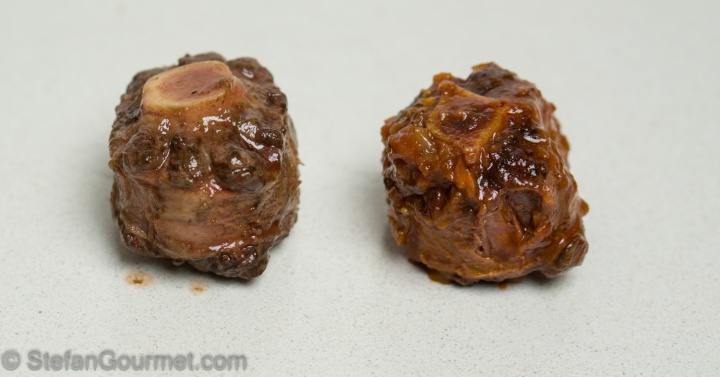
Side by side experiments are a great way to find out if what you are doing when cooking actually makes a difference. For instance, is it worth making pesto by hand with pestle and mortar instead of in the blender (it is), or is it worth cooking scallops sous-vide before searing them (it isn’t).
Something I’ve been wondering about for a long time but had not tested yet, was whether it makes a difference when cooking sous-vide to cook meat and sauce separately and then combine them, or to cook them together. Does the sauce penetrate the meat when cooking sous-vide? I was reminded about this when I recently did a post on cajun rabbit sous-vide, and Salilah asked “Have you done a comparison between this and cooking the rabbit SV (with maybe the salt and spices) and doing the sauce separately and then combining? I just wonder how much better the SV recipe might be (or not) with adding flavour – I’m not sure I always notice the flavour added when I SV meat.”
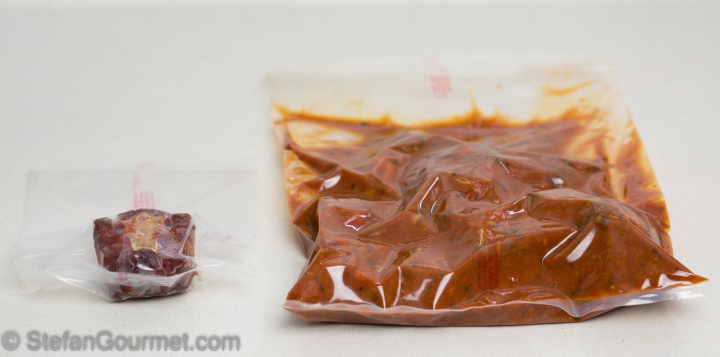
And so when I wanted to prepare coda alla vaccinara (oxtail stewed in tomato sauce Roman style) to free up some space in my freezer, I decided to prepare this sous-vide and perform a side by side experiment by cooking one piece of oxtail separately without the sauce.

As I wanted to taste whether the sauce had penetrated into the meat while cooking sous-vide, I rinsed both pieces of oxtail in cold running water to remove any sauce on the outside.

When I cut into the meat, it was immediately visible that the tomato sauce had penetrated all the way into the meat. I think the 100 hours of cooking time may have something to do with this. The tomato flavor had also penetrated the meat. This does make it less ‘beefy’, but the tomato flavor is of course what coda alla vaccinara is supposed to taste like. The meat was also a bit more flaky, probably because of the acidity of the tomatoes. The conclusion is that, certainly with longer cook times, it does make a very significant difference whether you cook the meat with or without the sauce. It is a matter of preference what you prefer, but for sous-vide versions of traditional stew dishes it is best to cook the meat sous-vide with the sauce.
This post is mostly about that experiment, as I have already posted about oxtail sous-vide (which requires a whopping 100 hours at 60ºC/140ºF to become tender) and a post about coda alla vaccinara. As with many traditional Italian recipes, there are many versions of it. This time I prepared it with cinnamon, guanciale, and carrots, but without lardo, cocoa powder, raisins, and pine kernels. Another reason for sharing the recipe for coda alla vaccinara sous-vide is that there are a few important rules to take into account when preparing a stew sous-vide:
- Stews usually contain vegetables, and they won’t become tender when cooked sous-vide at a temperature that is typical for cooking meat sous-vide. So the vegetables need to be tender before you start cooking sous-vide.
- As the stew is cooked sous-vide in an airtight plastic bag, it won’t reduce. Therefore, you need to reduce the sauce before cooking sous-vide.
- As the meat releases quite a bit of liquid as it is cooked sous-vide, you may need to reduce the sauce again afterwards. To prevent overcooking the meat, it is best to first reduce the sauce separately and then add back the meat to quickly reheat the outside of the meat.
- Browning the meat is an important step in stew recipes to add flavor, and this still needs to be done. Other than with most sous-vide recipes, this should be done before cooking sous-vide.
- If you add wine or another alcoholic beverage to the stew, make sure that the alcohol has evaporated before vacuum sealing. As alcohol has a lower boiling point than water, it may otherwise cause undesired effects.
- Vacuum sealing sauce is not straightforward. When vacuum sealing in a chamber vacuum sealer, make sure that meat and sauce are at least as cold as room temperature or preferably at refrigerator temperature, as otherwise the low pressure will cause the sauce (and juices in the meat) to start boiling. When using a ‘clamp’ vacuum sealer, you need to freeze the sauce first. If you don’t have a vacuum sealer or don’t want to freeze the sauce first, using a ziplock bag and the water displacement method is your only option. With long cooking times the small amount of residual air may cause problems.

If you like you can first serve half of the sauce over pasta (fusilli work very well as they ‘absorb’ the sauce) as primo piatto and then serve the oxtail with the remainder of the sauce as secondo piatto.
Ingredients
oxtail, about 6 meaty pieces
1 can (400 grams/14 oz) peeled tomatoes
1 carrot, 1 stick celery, 1 onion
1 clove garlic
1 Tbsp minced flat leaf parsley
50 grams (1.8 oz) guanciale (or pancetta or lardo)
80 ml (1/3 cup) red wine
80 ml (1/3 cup) beef stock
1/8 tsp cinnamon
salt and freshly ground black pepper
4 Tbsp olive oil
To finish the dish
1 carrot
1 stick celery
Preparation

Mince the guanciale, garlic, celery, carrot, parsley, and onion. Or chop it roughly…

…put it in the food processor…

…and let it take care of the rest.
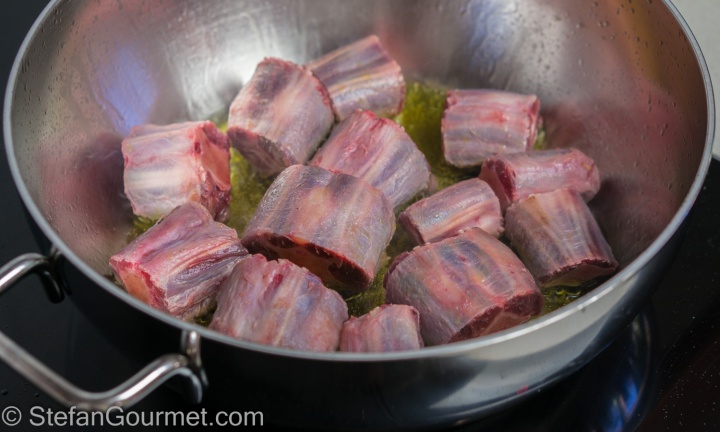
Heat the olive oil in a casserole over high heat. Add the oxtail.
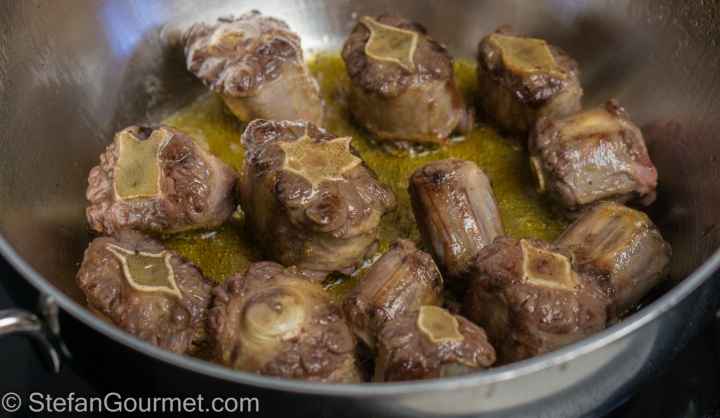
Brown the oxtail on all sides, then take it out of the pan and set aside.

Now add the minced vegetables…
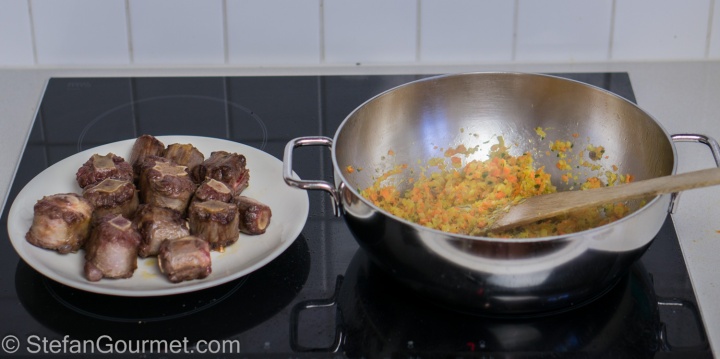
…and sauté them over medium heat…
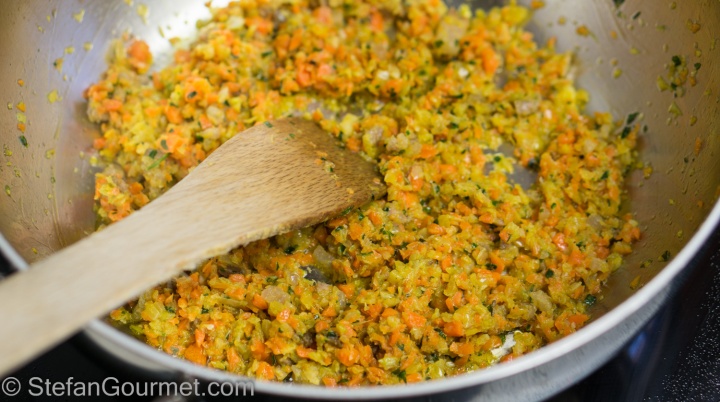
…until they are golden brown (about 10 minutes).
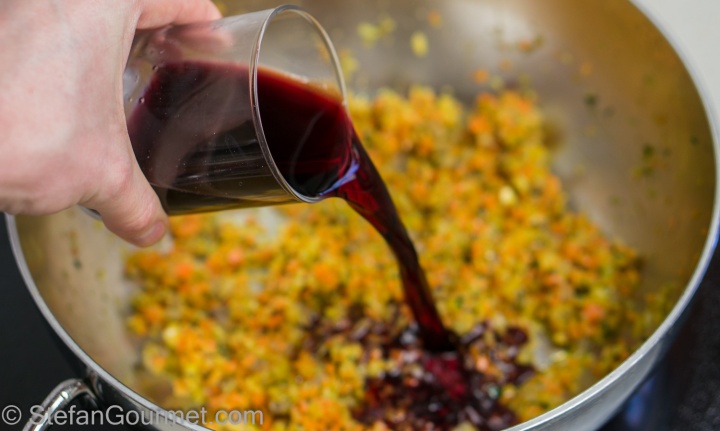
Then deglaze with the red wine and the beef stock.
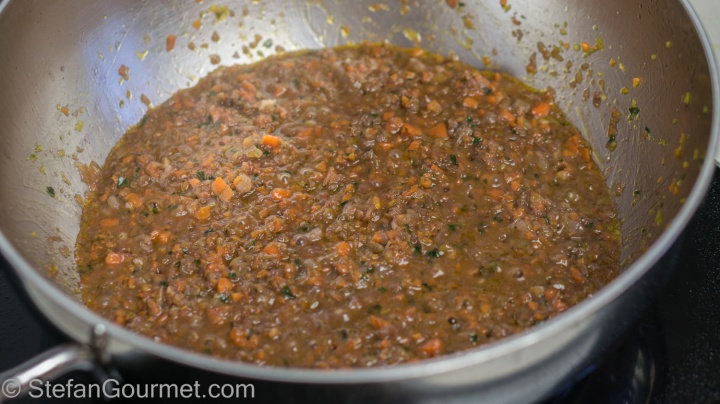
Allow the alcohol to evaporate.
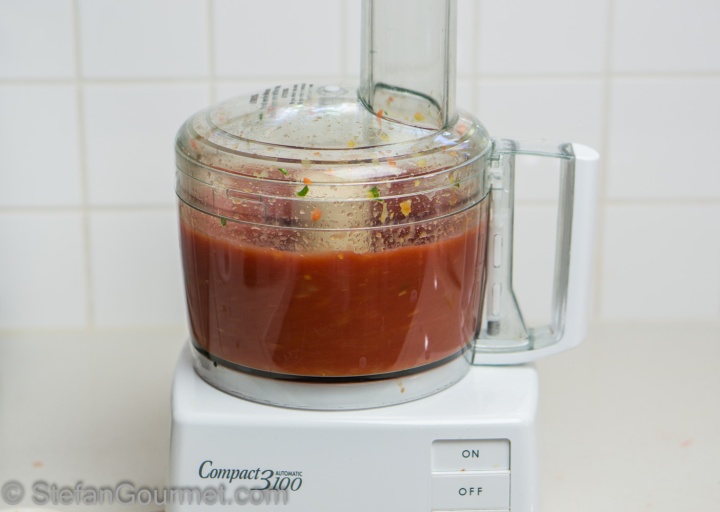
Puree the tomatoes in the food processor…
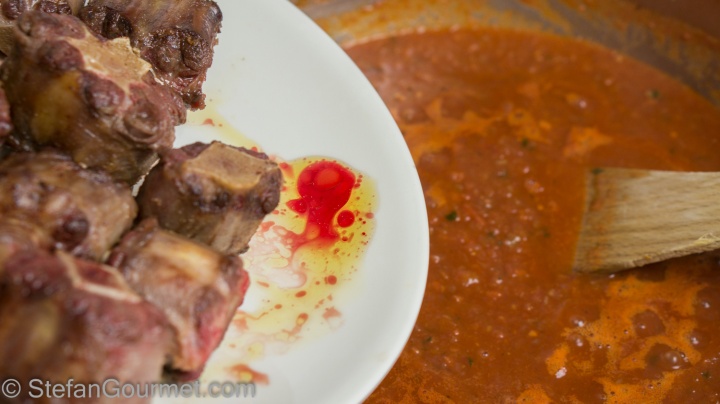
The oxtail will have leaked some juices. As we don’t want to discard anything that may add flavor to our stew, add them as well.

Now bring the sauce to a boil and then reduce the heat to a simmer.

Simmer until the sauce is a bit thicker than you want it to be, to account for the juices that will be released by the meat when cooked sous-vide.

Vacuum seal the meat together with the sauce, using one of the methods outlined above.
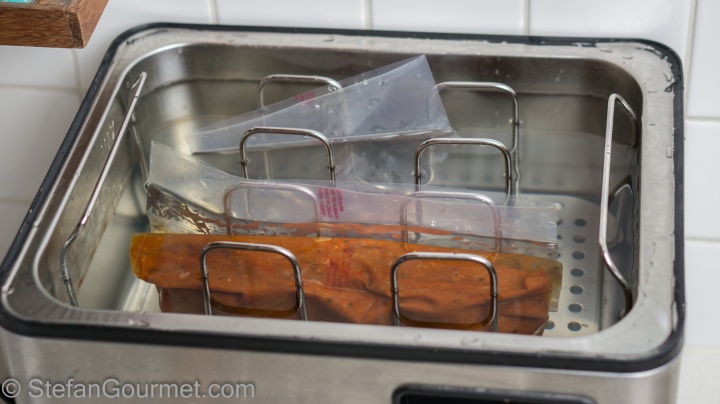
Cook sous-vide for 100 hours (4 days or 96 hours will also suffice) at 60ºC/140ºF.
Slice the carrot and the celery and boil or steam them until tender.
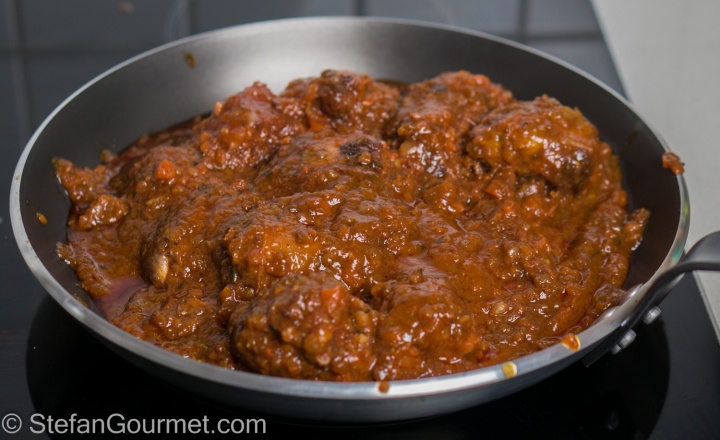
If all went well the sauce should not require additional reduction, but it may be nice to cook it for just a minute over high heat in a non-stick pan just to heat up the sauce a bit. Otherwise you will serve the stew at 60ºC/140ºF and it may cool off rather quickly.
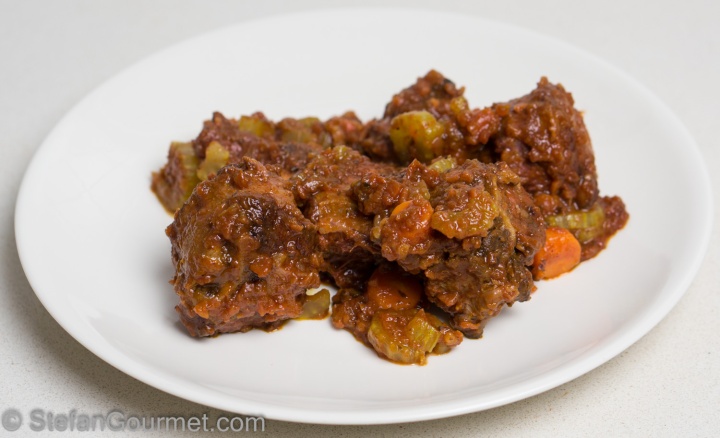
Stir to mix, and serve on preheated plates.
Flashback

This Easy Lemon Chess Pie is so easy that anyone can make it. And it is delicious all the same!

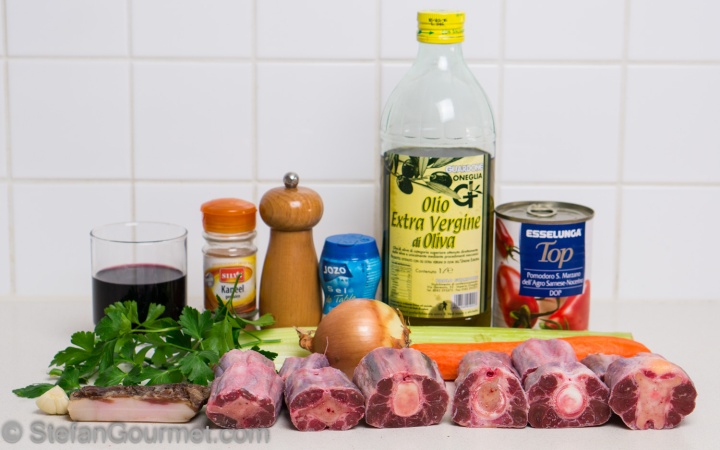




Complimenti, una ricetta fantastica.
La coda ha un aspetto succulento e la pasta è deliziosa.
Bravissimo. 🙂
Emanuele
LikeLike
Grazie per aver visitato il mio blog e lasciare un commento così carino.
LikeLike
Ci mancherebbe, i complimenti te li meriti tutti.
Continua così 🙂
LikeLiked by 1 person
I always love your side by side comparisons, Stefan!
LikeLiked by 1 person
Vedo che anche tu sei alle prese con gli ultimi piatti invernali. Questo piatto ha un aspetto davvero succulento!
LikeLiked by 1 person
Che bella ricetta!
LikeLiked by 1 person
Fantastic Stefan – cooking experiments – I love the fact that you did the head to head comparison – something I could also be found doing – only for those serious about their food and satisfying their curiosity! Love it. If ever you are in Vienna and want to have a break – check out this place: they serve wonderful things such as beetroot meringues with foie gras back when I still allowed myself to eat it, apple “dumplings” (made with granny smith apple juice and molecular cuisine techniques, I wrote down the recipe somewhere) – basically only made with apple – and then put into a gel state with special ingredients – served in a pumpkin sauce – the location is very romantic in the middle of the forest, although the rooms are more functional business hotel – great place for an offsite meeting! http://www.hanner.cc/uploads/Speisekarten/Restaurant_2015.pdf
LikeLiked by 1 person
Thanks for the link — the menu does look interesting.
LikeLike
you are welcome – really interesting menu and you don’t need to spend the night you can just have some dinner if ever you are in the area!
LikeLike
Are you kidding? After a dinner like that, with matching wines, I will need a bed for sure 😉
LikeLiked by 1 person
Hm good point – check out the romantic seating in front of the fire: https://polianthus.wordpress.com/2015/01/30/get-your-veg-on-with-this-voluptuous-italian-raw-vegetable-starter/
LikeLike
Really great commitment to the experiment. It looks delicious too.
LikeLiked by 1 person
Hi Stefan
Thank you a very much indeed for the excellent blog post. This one is near and dear to my heart and couldn’t have come at a better time. I have now been experimenting with sous vide for a few months but its been primarily with just the protein (chicken, steak and lamb) itself. I am originally from India, and if there one thing that makes the Indian heart sing, its a good curry. Now, curry as you well know is typically cooked by braising or slow cooking the protein with the spices and sauce. I has been wondering how this can be done sous vide and your post motivated me to try it. I decided to take a big (for me) short cut and use a prepared curry sauce that I picked up in a store (as opposed to making the sauce from ground up). I mixed up the sauce with a few skinless (but not boneless) chicken thighs in the bag and about a teaspoon of olive oil, added some salt and garam masala and cooked it sous vide for 1.5 hours at 73C. The result far surpassed my expectations. The chicken was cooked perfectly as expected. I separated the chicken from the sauce, added a little water and salt and boiled the sauce to deepen the flavour. In went the chicken and I kept it on the heat long enough to heat the chicken. Some cilantro on top and I had the perfect lunch of chicken curry with naan bread. So thank you to inspiring me to take the plunge.
I think using a prepared sauce is key because it doesn’t have to cooked. Normally the onion, garlic and ginger in the sauce gets cooked with the protein but I think that might be a challenge with sous vide because the temperature isn’t high enough to cook the onion, etc. A bottled sauce on the other hand contains cooked onion, etc., so it works ok. What do you think? You did cook the sauce before you mixed it with the ox tails.
I am now planning on using the same technique for a 48 hours goat curry. I will let you know how that goes.
Shantanu.
LikeLike
Hi Shantanu, thanks for taking the time to leave such a thoughtful reaction. I am really glad that it worked out for you. I have never cooked anything Indian, and would love to prepare an Indian curry sous-vide with a sauce made from scratch. You would indeed have to cook it and it would also be nice to brown the chicken (is this generally done with chicken curry?) before cooking it sous-vide too for an additional layer of flavor.
You may like this recipe for lamb shank cooked sous-vide with yogurt, you can easily change the spices to your liking: https://stefangourmet.com/2014/10/08/lamb-shank-with-eggplant-and-yogurt/
For chicken that is even more tender and a longer time for the flavor to develop, you could also try the chicken thighs cooked at 62C for 12 hours.
I would love to hear about the goat curry. For 48 hours I would imagine 57C?
LikeLike
Hi Stefan. I too have been intrigued by the prospect of the 12 hour chicken thighs. I think I will try that next. My wife doesn’t like the slightest trace of pink in cooked chicken, so I tend to be extra cautious about the level of done-ness. Nevertheless, I will give it a go. There is a marked more intense chicken taste when cooked sous vide. Indians generally do not eat chicken with skin (it was a bit of a cultural shock to me when I came to the US and saw people eat chicken skin 🙂 ), so browning the chicken itself isn’t usually a part of the recipe. However, sauteing the chicken with just the spices before the addition of onion or tomatoes is very common. If I cook with the skin intact, then I usually brown the chicken to take advantage of the fond.
Your lamb shank with yogurt is definitely on my list of 48 hour recipes. I intend to cook the goat at the same temp at the lamb shank.
Cheers!
Shantanu.
LikeLike
Hi Stefan! Thanks for the experiment – really interesting!! 100hours – wow! I tend to think of 16 hours or so (duck legs for confit) as a long time – will have to wait until I retire I think to get this much time in one lump (we stay in London during the week so weekends with the SV are all we have)
Interesting re the taste – I wonder if it is to do with time? I’ve mainly tried things with a shorter time – might try e.g. the duck legs one with bay leaves and juniper and stuff, and the other plain, as an experiment – mind you, it will mean fending off my partner when serving up, he does tend to wolf stuff!
Another tech question (as I bake bread and make cheese) – salt. Salt draws out the liquid as well as flavouring – so should we use this before or after SV? I noticed in your venison shoulder (I need to find a good butcher) that you used salt and pepper before SV – I tend to add at the end?
thanks loads for the post, though – a great experiment!
Salilah
LikeLike
This was just fabulous! Followed the recipe exactly. Gained much respect from extended family who thought I couldn’t cook…
LikeLiked by 1 person